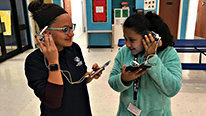- Marc Lesser
- https://mouse.org/marc-lesser
- Chief Learning Officer
- Investigating Digital Badges as Alternative Credentials to Broaden STEM Participation Among Underrepresented Youth
- https://mouse.org/news/mouse-elated-greenlight-on-itest-from-national-science-foundation
- Education Development Center (EDC), Mouse, Parsons School of Design
- Jaime Gutierrez
- Investigating Digital Badges as Alternative Credentials to Broaden STEM Participation Among Underrepresented Youth
- https://mouse.org/news/mouse-elated-greenlight-on-itest-from-national-science-foundation
- Education Development Center (EDC)
- Wendy Martin
- http://www.edc.org/wendy-martin
- Research Scientist
- Investigating Digital Badges as Alternative Credentials to Broaden STEM Participation Among Underrepresented Youth
- https://mouse.org/news/mouse-elated-greenlight-on-itest-from-national-science-foundation
- Education Development Center (EDC)
Public Discussion
Continue the discussion of this presentation on the Multiplex. Go to Multiplex









Wendy Martin
Research Scientist
Thanks so much for watching our video! We welcome your comments. One conversation we would like to have is about the kinds of partnerships informal STEM programs can develop (such as with higher ed institutions, but other organizations as well) that can help youth succeed along education and career pathways. If you are engaged in such efforts, please share what you are doing to establish those relationships.
Marc Lesser
Brian Drayton
Co-Director
Intriguing work, thanks for an interesting video.
You mention a bit about the impact that the portfolio has on the students' sense of accomplishment, and the partnership that's doing this work helps create a sense of reality for them about the value of the skills they're learning. Have you followed some of your "alums" into their post-secondary lives, to understand how their experience in your program affects [a] selection of further trainiing, [b] success in applications to college (or other post-secondary) opportunities; [c] actual effects on learning or professional growth in post-secondary settings (I am being generic, since I can imagine that the pathways from this program may be quite various!).
Marc Lesser
Alice Anderson
This sounds like a really valuable partnership to all the organizations involved. I was intrigued by the visioning session you described, which led to shared values for the partnerships. How was that session facilitated? How have the partners returned to those values throughout the project? Have they changed at all over time?
Marc Lesser
Julie Poncelet
Hello Alice,
Thank you for viewing the video on the Design League Badge Portfolio project and the supporting partnership. I’m following-up on Wendy’s post about the visioning work realized by the partnership in Year 1 and revised bi-annually. I used Liberating Structures Purpose to Practice (P2P - http://www.liberatingstructures.com/33-purpose-...) to structure the conversation around purpose, principles, participants, structures, and practices. A copy of the facilitator agenda is available here - https://drive.google.com/file/d/1r8d1bBFkIgC-R7... and a photo of our meeting ‘harvest’ is available on our badge wiki here - https://badge.wiki/wiki/Partnership_Case_Study:....
The design of the evaluation is developmental in nature to align with the project’s DBIR approach. As part of the evaluation, I facilitate quarterly check-in calls with each of the partners during which we discuss several items, including partnership practices and principles relative to realizing the partnership’s purpose. I also implement a bi-annual (Year 1 and Year 2)/annual (Year 3) survey with the partners to gather feedback on the vision. I document the information collected through this process in Rapid Feedback Memos, which are shared with the partnership (3-4 memos annually) and integrated into partnership meetings and retreat discussions.
I would say that the elements that make up the vision have become more explicit or better articulated (internally and externally) over time. Having the vision in place has held partners accountable to specific practices and principles, which has kept the project moving (and with all partners involved actively, which is critical to the research aspect of the work!). It has also helped to surface assumptions brought into the project that called for more in-depth conversations/exploration and informed programmatic shifts (thereby supporting the DBIR process).
Do not hesitate to let me know if you have any additional questions about the visioning process!
Wendy Martin
Research Scientist
Thanks for your comments! Brian, the team has maintained relationships with some alums, one of whom goes to Parsons and who speaks in the video. However, we would like to do more follow up with them in the next phase of the project. Our final interviews with participants will be focused on applying to college so we'll know more in a month or so, and we hope to do future project that will allow up to keep in touch with students as they move on to college.
Wendy Martin
Research Scientist
Hi Alice! Thanks for your question. Our excellent evaluator Julie Poncelet facilitated the visioning session, which was extremely helpful to get us all on the same page. it was done at all day retreat where we had to identify core values, inputs and outputs and anticipated outcomes. Lots of colored post-its. Then Julie created a document that synthesized our vision. It has been useful to have that to go back to as we go through the day to day program and research activities. I'll ask Julie is she wants to chime in.
Ginger Fitzhugh
Senior Research Associate
Very interesting work! Could you describe a bit more about the badging program and how it relates to the portfolios? What platform did you decide to use for the badges? I know that it can be challenging to develop badges that are sufficiently specific and yet widely recognized.
Marc Lesser
Marc Lesser
Chief Learning Officer
Thanks Ginger! I'd love to.
Victor van den Bergh
User Researcher & Evaluator
I'm also curious to know more about how students are awarded badges. I read that the badges are curated by students, but do instructors hand out the badges at the end of a project and are there detailed learning objectives associated with each badge? Have you ever awarded badges for projects students have done outside of the classroom/mouse setting? Thank you for sharing your work!
Marc Lesser
Marc Lesser
Chief Learning Officer
Victor, great questions, thank you.
Issuing badges is a very programmatically driven task. It can't be an afterthought, or a thing that happens behind the scenes the way that conventional accountability works. Our instructors have tried quite a few things through this project, including making the process more visual through posters that hang in the space. Over time, badges have become integrated with the process of "documentation". The more young designers are documenting and showing their work iteratively, the more substantial their evidence for credentials is. Program leads, along with portfolio mentors, assess that work and issue badges at the end of programmatic intervals that line up, in our case, with phases in the design process.
Re. Objectives: every credential we issue is designed with a "criteria" that is transparent to learners and educators, both. Those criteria are curated with endorsers from higher ed in order to identify ways of strengthening programming to better support students who want to follow design/tech pathways moving forward.
Read more about the program here. Let me know if you have more questions. Happy to offer more info.
Here's a wiki article written that describes more as well: https://badge.wiki/wiki/Programmatic_Foundations_for_Badge_Portfolios
Lynn Cominsky
We considered the use of digital badges for students and also for teachers within our Learning by Making program, as we concentrate on several important skills that would be good to recognize in some way. But because we are part of the formal learning framework, it was hard to justify another way of grading the students besides just giving them grades, and having them create projects for portfolio-type assessment.
I love the emphasis on meeting societal needs - I also teach a class that originates with an NSF grant that is for sophomore college students that uses our new campus Makerspace to create things needed by community partners. Maybe we will make next year's video about that project!
Marc Lesser
Marc Lesser
Chief Learning Officer
Lynn - thanks for the interest and sharing more about what you're up to. It sounds outstanding.
You're right that a move to badges/credentials is a move to portfolio-based pedagogy and assessment and that's easier to swallow in some places more than others. Check out Mastery Transcript Consortium if you don't know them already, for some interesting ideas, and separately, here's a link to my podcast where I interviewed a great school-based project called "Competency X" in San Diego county, CA. I think you'll pull a lot of useful info from my guest, Alec Barron.
Heidi Carlone
Great discussion above! Great project. Love the combination of design work, engineering, digital badges, and altruism embedded in the project. Thanks for the great work!
Marc Lesser
Further posting is closed as the showcase has ended.